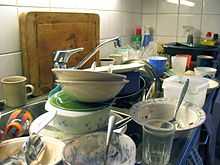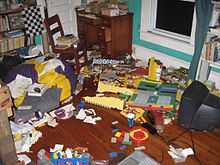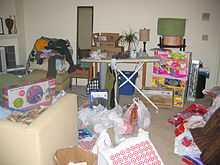Housewife

A housewife is a woman whose main occupation is running or managing the family's home—caring for and educating her children, cooking and storing food, buying goods the family needs in day to day life, cleaning and maintaining the home, making clothes for the family, etc.—and who is generally not employed outside the home.[1] Merriam Webster describes a housewife as a married woman who is in charge of her household.
The term may sometimes be used in contrast to a career woman.
Economics


Some feminists,[2][3] and non-feminist economists (particularly proponents of historical materialism) note that the value of housewives' work is ignored in standard formulations of economic output, such as GDP or employment figures. Housewives work many unrecorded hours a week, while depending for money on their husband's or partner's employment.
Sociology
Traditional societies
For many thousands of years, men have generally been thought of as the main "breadwinners" in families: it was mainly their job to hunt animals for food, grow food crops or earn money, while the women have cared for children, prepared food for eating, cleaned the house, and made and cared for clothes.
In societies of hunters and gatherers, for example the traditional society of the Australian aboriginal people, the men hunt animals for meat, and the women gather other foods such as grain, fruit and vegetables. One of the reasons was that it is much easier to gather fruit while looking after a baby than to hunt a fast-moving animal. Even when homes were very simple and there were few possessions, men and women did different jobs.
In rural societies, where the main work is farming, women have also taken care of gardens and animals around the house, and helped men with heavy work whenever a job needed doing in a hurry, usually because of the season.
Examples of the heavy work that a traditional housewife (homemaker) in a rural society would do are:
- Picking fruit when it was ripe for market
- Planting rice in a paddy field
- Harvesting and stacking grain
- Cutting hay
In rural studies, the word "housewife" is occasionally used to refer to the person who does the majority of the chores within a farm's compound as opposed to field and livestock work[citation needed].
Urban societies
In an urban society, most people live in towns and cities. In urban societies, since ancient times, most men did work that earned money. They worked in workshops, banks, shops and other businesses as well as in churches, schools and the town council. It was seen as the job of a woman to be a "housewife" (homemaker).
But the reality was often different[citation needed]: often, if a family had a business, not only the husband but also the wife would work to make money in the business. This has been happening since ancient times.[citation needed]
In every society there are some women who never marry.[citation needed] They might stay at home and do housework for other family members, or they might work outside the house. In many urban societies, there were few jobs that a woman was allowed to do. In modern society there are still strong traditions about the jobs that women should do.[citation needed]
Modern society
In the 19th century more and more women in industrialising countries stopped being homemakers and began to do jobs that men usually did. At this time many big factories were set up, first in England then in other European countries and the United States. Many thousands of young women went to work in factories.
Other women, like Florence Nightingale, decided to go against the social norm, and partake in harder, money earning professions, even if they were rich and therefore did not need to work. In most families where there was a husband and wife, the social norm dictated that it was the job of the husband to earn money and the job of the woman to be the "housewife" (homemaker). Women were often very proud to be a good homemaker and have their house and children respectably taken care of.
In the early 20th century the two world wars (World War I, 1914–18, and World War II, 1939-45) were fought by men from many countries. While the men were at war, their wives went to work to keep the countries running. Women, who were also homemakers, worked in factories, businesses and farms. At the end of both wars, many men had died, others had returned injured and some men were able to return to their previous positions. However the wars had taught them different, resulting in more employability. As a result, women kept doing many of the jobs they had commenced during the wars.
By the 1960s in western countries, it was becoming more accepted for a woman to work and be a "career girl" until the woman got married, when she should stop work and be a "housewife". Some jobs like teaching were only done by unmarried women. Many western women in the 1970s believed that this was not treating men and women equally and that women should do whatever job they were able to do, whether they were married or not.
At this time, women were becoming more educated. As a result of this increased education, some women were able to earn more than their husbands, so the husband would remain at home to raise their young children. This was not commonplace.
In the late 20th century, it became harder for a family to live on a single wage. Subsequently, many women were required to return to work following the birth of their children however often they continue the "homemaker" role within the family. It is becoming more commonplace for the husband and wife to be employed in paid work and both share in the "housework" and caring for the children. In other families, there is still a traditional idea that housework is only a woman's job, so that when a couple get home from work, it is only the wife who works in the house, while the man takes a rest after his day's work.
What a housewife does





The job of a housewife is to take care of her husband and other members of the household and participate in the care of their home. Some of the usual things that a housewife does are:
- Child care (where applicable)
- Getting children ready for school and work
- Volunteering for school canteen and other jobs
- Bathing and dressing children
- Feeding babies
- Wiping noses and bottoms
- Playing with children
- Comforting babies, children and partners
- Driving the children to school and other activities
- Helping with homework
- Supervising music practice
- Reading storybooks
- Stopping fights
- Cleaning, decorating and provision of clothing
- Cleaning the home
- Seasonal cleaning like washing the curtains and beating carpets
- Cleaning out the garage
- Decorating (arranging the furniture and ornaments, and choosing the colours of things)
- Washing clothes
- Ironing clothes
- Mending clothes (and sometimes making them)
- Shopping for new clothes and other family needs
- Tends the garden
- Eldercare (where applicable)
- Food-related
- Planning meals
- Buying food
- Preparing and cooking food
- Serving food
- Washing up after meals
- Health care and companionship
- Doing first aid
- Caring for sick people
- Caring for pets
- Listening to people's stories of their day
- Giving advice
- Entertaining guests
- Remembering everybody's birthday
- Fixing things that go wrong
- Remembering what everyone else has forgotten
- Finding lost things
- Putting people to bed
- Kissing people goodnight
- Keeping up with finances, daily household items, and expenses
- Paying monthly household bills in a timely manner
- Making sure all household issues are resolved regarding health/car insurance, cell phone bills, doctor appointments, etc.
- Managing spending
- Any other secretarial duties that need to be done to help run a smooth partnership with the husband that is working to pay the bills
Songs about the housewife's lot
The housewife's tasks have often been the subject of songs. These include: "The Housewife's Lament" (from the diary of Sarah Price, Ottowa, Illinois, mid 19th century);[4] "Nine Hours a Day" (1871 English song, anonymous); "A Woman's Work is Never Done"[5] or "A Woman Never Knows When her Day's Work is Done"; "The Labouring Woman"; How Five and Twenty Shillings were Expended in a Week" (English popular songs); "A Woman's Work" (London music hall song by Sue Pay, 1934).[6]
Housewives by country
In China
In imperial China (excluding periods of the Tang dynasty when women had higher status in society), women were bound to homemaking by the doctrines of Confucianism and cultural norms. Generally, girls did not attend school and, therefore, spent the day following their mothers and female relatives in household chores (for example, cooking and cleaning), which would assist them after their marriages. In most cases, the husband was alive and able to work, so the wife was almost always forbidden to take a job and mainly spent her days at home or doing other domestic tasks. As Confucianism spread across East Asia, this social norm was also observed in Korea, Japan and Vietnam.
After the founding of the Republic of China in 1911, these norms were gradually loosened and many women were able to enter the workforce. Shortly thereafter, a growing number of females began to be permitted to attend schools. Starting with the rule of the People's Republic of China in 1949, all women were freed from compulsory family roles. During the Great Leap Forward and Cultural Revolution, some women even worked in fields that were traditionally reserved for males.
In modern China, housewives are no longer as common, especially in the largest cities and other urban areas. Many modern women work simply because one person's income is insufficient to support the family, a decision made easier by the fact that it is common for Chinese grandparents to watch after their grandchildren until they are old enough to go to school. Nonetheless, the number of Chinese housewives has been steadily rising in recent years as China's economy expands.
In India and Pakistan
In India different approaches to domestic responsibilities are found in the various ethnic groups.
In a Hindu family, the head of the family is the Griha Swami (Lord of the House) and his wife is the Griha Swamini(Lady of the House). The Sanskrit words Grihast and Grihasta perhaps come closest to describing the entire gamut of activities and roles undertaken by the householder or housewife. Grih is the Sanskrit root for house or home; Grihasta and Grihast are derivatives of this root, as is Grihastya. The couple lives in the state called Grihastashram or family system and together they nurture the family and help its members (both young and old) through the travails of life. The woman who increments the family tree (bears children) and protects those children is described as the Grihalakshmi (the wealth of the house) and Grihashoba (the glory of the house). The elders of the family are known as Grihshreshta. The husband or wife may engage in countless other activities which may be social, religious, political or economic in nature for the ultimate welfare of the family and society. However, their unified status as joint householders is the nucleus from within which they operate in society. The 'status' of a woman as a housewife anchors them in society and provides meaning to their activities within the social, religious, political and economic framework of their world. However, as India undergoes modernisation, many women are in employment, particularly in the larger cities such as Mumbai or Delhi, where most women will work.
In Muslim families, use of the term housewife (or its equivalent) is uncommon, even though housewives are very common and stay-at-home husbands are extremely rare. Muslim society sets different expectations for the husband and wife, but respects their individuality. Families are generally viewed as sets and not units[citation needed].
In the United Kingdom
Two British magazines for housewives have been published: The Housewife (London: Offices of "The Million", 1886-[1900]) and Housewife (London: Hultons, 1939–68).[7]
"On a Tired Housewife" is an anonymous poem about the housewife's lot: "Here lies a poor woman who was always tired, / She lived in a house where help wasn't hired: / Her last words on earth were: «Dear friends, I am going / To where there's no cooking, or washing, or sewing, / For everything there is exact to my wishes, / For where they don't eat there's no washing of dishes. / I'll be where loud anthems will always be ringing, / But having no voice I'll be quit of the singing. / Don't mourn for me now, don't mourn for me never, / I am going to do nothing for ever and ever.»"[8]
In the United States

In previous decades, there were a large number of mandatory courses for young women to learn the skills of housework. In high school, courses included sewing, cooking, nutrition, home economics, family and consumer science (also known as F.A.C.S) and food and cooking hygiene. More recently, these courses have been mostly abolished, and many people of both sexes in high school and college would be more likely to explore resources on the more academic topics of child development, child psychology and managing children's behaviour[citation needed].
Some modern women are leaving the paid workforce and concentrating full-time on child-rearing; particularly through their child(ren)'s early years (before entering kindergarten). There is considerable variability within the stay-at-home mother population with regard to their intent to return to the paid workforce. Some plan to work from their homes, some will do part-time work, some intend to return to part or full-time work when their children have reached school age, some may increase their skill sets by returning to higher education, and others may find it economically feasible to refrain from entering (or re-entering) the paid workforce.
Similarly, there is considerable variation in the stay-at-home mother's attitude towards domestic work not related to caring for children. Some may embrace a traditional role of housewife, cooking and cleaning in addition to caring for children. Others see their primary role as that of child-care providers, supporting their children's physical, intellectual, emotional, and spiritual development while sharing or outsourcing other aspects of home care.
See also
- Gender roles in agriculture
- "Good Wife's Guide"
- Home and family blog
- Stay-at-home dad
- Soccer mom
- The Compleat Housewife or Accomplish'd Gentlewoman's Companion, an English cookbook and how-to manual; also the first published cookbook in the United States
- The Real Housewives
- Women's work
References
- ↑ Macmillan dictionary definitionj
- ↑ Luxton, Meg; Rosenberg, Harriet (1986), Through the Kitchen Window: The Politics of Home and Family, Garamond Press, ISBN 978-0-920059-30-2
- ↑ Luxton, Meg (1980), More Than a Labour of Love: Three Generations of Women's Work in the Home, Women's Press, ISBN 978-0-88961-062-0
- ↑ Recorded on: The Female Frolic, Argo ZDA 82 & Seeger, P. Penelope isn't Waiting any More Blackthorne BR 1050
- ↑ Recorded on Staverton Bridge SADISC SDL 266
- ↑ Kathy Henderson et al., comp. (1979) My Song is My Own: 100 women's songs. London: Pluto; pp. 126-28, 142-43
- ↑ Held by various libraries in the UK; Copac
- ↑ The Penguin Book of Comic and Curious Verse, ed. J. M. Cohen. Harmondsworth: Penguin, 1952; p. 31
- General
- Allen (Consultant Editor), Robert (2003 (et seq)). The Penguin English Dictionary. 80 Strand, London, WC2R 0RL, London, England: Penguin Books. p. 1642. ISBN 0-14-051533-X.
Further reading
- Swain, Sally (1988) Great Housewives of Art. London: Grafton (reissued by HarperCollins, Lonon, 1995) (pastiches of famous artists showing housewives' tasks, e.g. Mrs Kandinsky Puts Away the Kids' Toys)
- United States
- Campbell, D'Ann (1984). Women at War with America: Private Lives in a Patriotic Era, on World War II
- Ogden, Annegret S. (1987) The Great American Housewife: From Helpmate to Wage Earner, 1776-1986
- Palmer, Phyllis (1990). Housewives and Domestic Servants in the United States, 1920-1945.
- Ramey, Valerie A. (2009), “Time Spent in Home Production in the Twentieth-Century United States: New Estimates from Old Data,” Journal of Economic History, 69 (March 2009), 1–47.
- Ulrich, Laurel Thatcher (1982). Good Wives: Image and Reality in the Lives of Women in Northern New England, 1650-1750
- Europe
- Draznin, Yaffa Claire (2001). Victorian London's Middle-Class Housewife: What She Did All Day 227pp
- Hardy, Sheila (2012) A 1950s Housewife: Marriage and Homemaking in the 1950s. Stroud: the History Press ISBN 978-0-7524-69-89-8
- McMillan, James F. (1981) Housewife or Harlot: The Place of Women in French Society, 1870-1940 229pp
- Robertson, Una A. (1997) Illustrated History of the Housewife, 1650-1950 218pp (on Britain)
- Sim, Alison (1996). Tudor Housewife, (on 1480 to 1609 in England)
External links
| Look up homemaker in Wiktionary, the free dictionary. |
- Home Economics Archive: Tradition, Research, History (HEARTH), An e-book collection of over 1,000 classic books on home economics spanning 1850 to 1950, created by Cornell University's Mann Library.
- Homemaking on the Open Directory Project